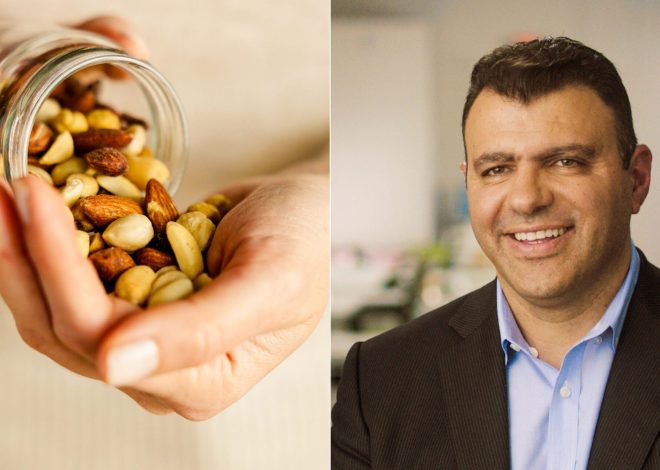
Plant Points: 30 plants per week
A new nutritional trend is currently emerging on social media. According to it, you should consume 30 “plant points” per week. We explain what this is all about.
Anyone who has ever thought about healthy eating has probably heard of the “5 a day” rule. According to this, you should eat 5 portions of fruit and vegetables every day. The “30 Plant Points Challenge” is a further development of this in a way. The theory, which has also become known as the “diversity diet”, was published a few years ago by the London-based Australian doctor Dr. Megan Rossi. But the diet is now experiencing a new boost thanks to a Netflix documentary.
In April 2024, “Hack Your Health: The Secrets of Our Digestion” was released on Netflix. Directed by Anjali Nayar, this film features various experts explaining everything to do with the intestines, intestinal health and the microbiome. Among them is Giulia Enders, who became known in this country through her bestseller “Gut with Charm”.
In this documentary, Arpana “Annie” Gupta, a neuropsychologist at the University of California, briefly introduces her “ABC” concept. ABC stands for “Always be counting”. However, this does not refer to counting calories, as is common in many diets, but to counting the plant-based foods you eat. Gupta says you should eat 20 to 30 different types of fruit and vegetables or plant-based foods per week to improve your gut health.
30 plants per week
30 plants per week – Rossi introduced this concept in her book “Eat Yourself Healthy” (ADVERTISEMENT) in 2019. The Netflix documentary has now turned it into a real trend, with Plant Points Challenges on social media & Co. Each plant ingredient eaten is worth 1 Plant Point awarded, for herbs you get half or a quarter point depending on the challenge. There is no single Plant Point Challenge or really set rules. They all have one thing in common: you should eat 30 plant-based foods per week.
You can eat the following foods to get 30 plants per week. In brackets you will find the fiber per 100 grams.
|
Nuts & Seeds
|
Bread, cereals & pseudo-cereals
|
|
Fruit & Berries
|
Vegetables & Mushrooms
|
|
legumes
|
Herbs
|
But what is the purpose of this diet? With the help of Diversity Diet – that is, a varied diet – we should consume sufficient and varied fiber. According to the German Nutrition Society, Dietary fiber is found almost exclusively in plant foods and mushrooms. Legumes such as beans or chickpeas, but also nuts and seeds are particularly rich in fiber. Whole grain products, vegetables and fruit are also good sources of fiber.
The DGE recommends at least 30 g of fiber per day or around 14.6 g of fiber per 1000 kcal. In “Hack Your Health”, microbiologist Justin L. Sonnenburg (Stanford) even recommends consuming 50 g of fiber per day.
But studies also show that in Germany, women only consume around 18 g of fiber per day and men around 19 g. In the USA, according to the Netflix documentary, it is even less, with an average of 15 g per day. If you want to follow the recommendations of the DGE and other experts, it is probably not bad at all to make sure to eat 30 plants per week.
Depending on your diet, 30 plants per week can be a challenge, especially since you also have to eat a certain amount to get enough fiber. Recipes that combine different types of fruit and vegetables such as smoothies, soups or baked vegetables. You can add nuts, seeds and herbs as a topping to almost all dishes.
Also read: Healthy nutrition – all important rules and basics
That’s why fiber is important for health
Dietary fiber has a wide range of effects on the body, especially on digestion. Foods with lots of fiber keep you full longerprevent constipation and generally have a positive effect on the mass and consistency of stool. Foods rich in fiber also stay longer in the stomach and intestines, which Improved nutrient absorption and they represent a good source of food for the microbiome.
The term Microbiome In this case, refers to the microorganisms that are found in the human digestive tract, especially in the intestine. These include bacteria, fungi, viruses and other microbes. The microbiome plays an important role in digestion, the production of vitamins, the regulation of the immune system, metabolism (energy balance, fat storage) and general intestinal health.
If the diet is too one-sided and contains too little fiber, the diversity of the microbiome and the number of beneficial bacteria in the intestine can decrease. At the same time, harmful bacteria can multiply, leading to Inflammatory reactionsbreakdown of the intestinal mucosa, constipation and other metabolic problems. The consequences can be, for example, obesity or type 2 diabetes.
Also interesting: Losing weight doesn’t work? – The 6 main reasons
But the microbiome in the intestine not only influences digestion, but also overall healthConnections between the gut and the brain are evident, for example, in autism, Parkinson’s disease and also stress-related psychiatric illnesses such as anxiety disorders and depression.
Anyone who wants to eat more fibre (again) after a phase with little fibre may initially feel bloated or experience stomach pain. In this case, it is recommended to first to start with smaller portions and to gradually get the digestive tract used to a high-fiber diet again.
In order to reshape the ecosystem in the intestine, it sometimes requires 9 to 12 monthsAnyone who goes on a short-term diet or changes in diet and then falls back into old patterns runs the risk of the yo-yo effect – partly because of the microbiome.

Ethel Purdy – Medical Blogger & Pharmacist
Bridging the world of wellness and science, Ethel Purdy is a professional voice in healthcare with a passion for sharing knowledge. At 36, she stands at the confluence of medical expertise and the written word, holding a pharmacy degree acquired under the rigorous education systems of Germany and Estonia.
Her pursuit of medicine was fueled by a desire to understand the intricacies of human health and to contribute to the community’s understanding of it. Transitioning seamlessly into the realm of blogging, Ethel has found a platform to demystify complex medical concepts for the everyday reader.
Ethel’s commitment to the world of medicine extends beyond her professional life into a personal commitment to health and wellness. Her hobbies reflect this dedication, often involving research on the latest medical advances, participating in wellness communities, and exploring the vast and varied dimensions of health.
Join Ethel as she distills her pharmaceutical knowledge into accessible wisdom, fostering an environment where science meets lifestyle and everyone is invited to learn. Whether you’re looking for insights into the latest health trends or trustworthy medical advice, Ethel’s blog is your gateway to the nexus of healthcare and daily living.



